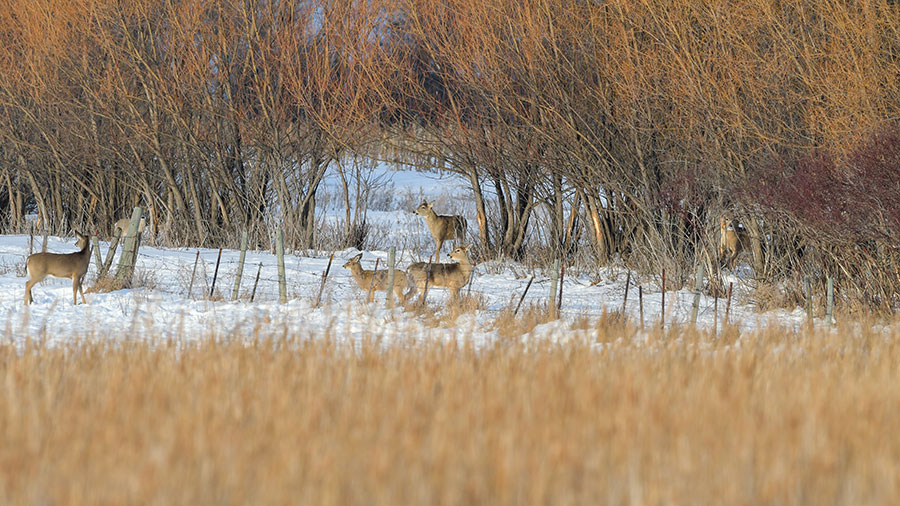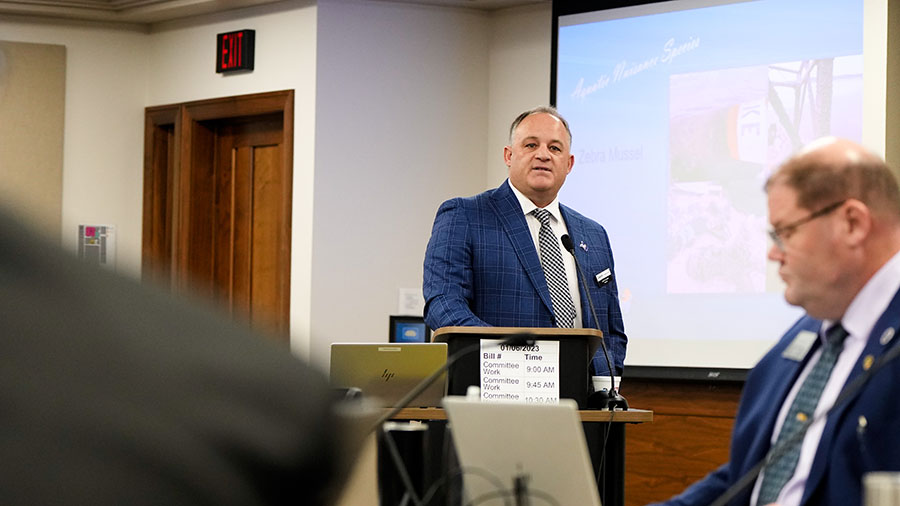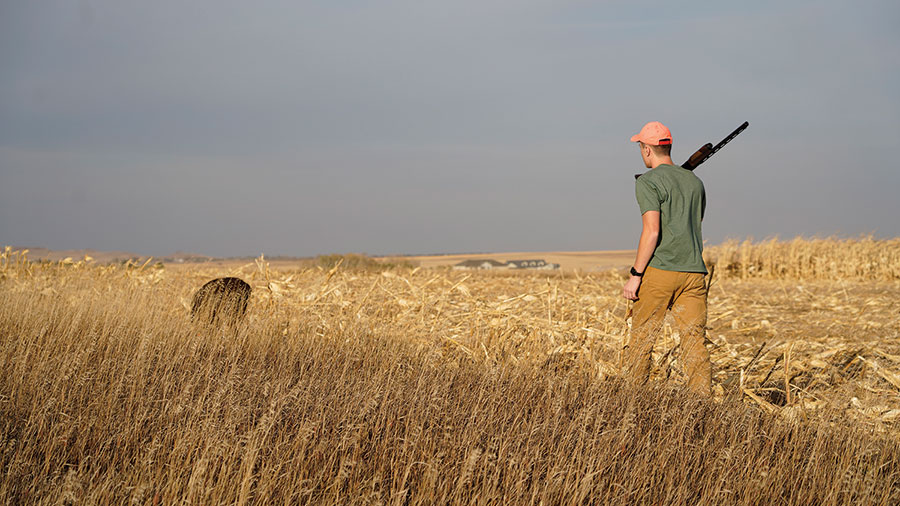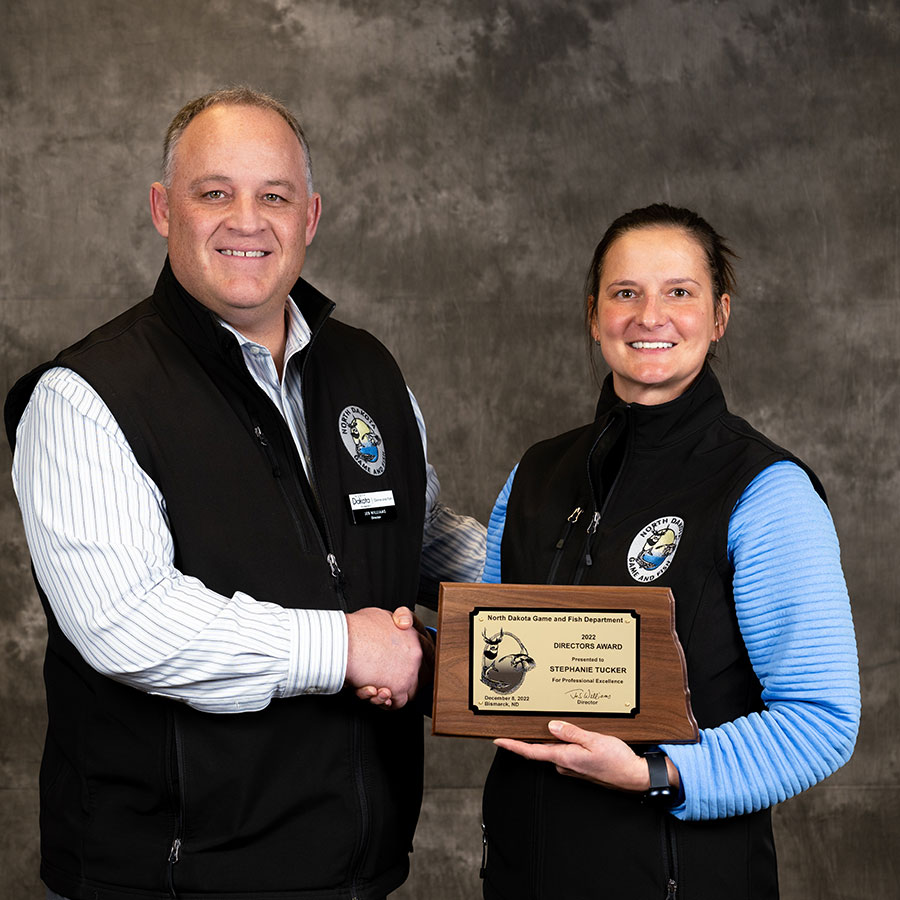Wildlife managers urge outdoor enthusiasts to consider where they recreate during North Dakota’s leanest months to spare already stressed animals simply trying to survive the elements.
While this advice is true during any Northern Plains winter, it hits this year with some significance considering winter arrived in mid-November with purpose and no sign of when it will end.
Game and Fish Department managers understand North Dakotans want to get outdoors and have fun in winter because we have several months of it. Even so, the tougher the winter is, it is important that people riding snowmobiles, shed hunting or doing whatever are cognizant about where wildlife are and to view them from a distance.
That means waiting to shed hunt until later in the spring so that you’re not pushing deer in and out of thermal cover where they’re trying to just conserve energy. Animals forced into the open are exposed to the elements a lot more, which adds further stress. Also, people need to realize that harassing wildlife from snowmobiles or other machines is illegal in North Dakota.
It’s common for snowmobilers and others to ride in areas where snow has accumulated, such as near shelterbelts and other wooded habitat because that’s where the drifts are, but people also must realize there could be deer or other wildlife within those areas to get out of the weather. So, every time animals are pushed from those areas, it increases the amount of energy they expend to survive the next day.
These same warnings, for shed hunters and others, also apply on Game and Fish Department owned or operated wildlife management areas where many animals gather to weather the winter months.
The North Dakota Game and Fish Department is tracking hunting and fishing issues during the 2023 legislative session.
Outdoor enthusiasts can follow proposed outdoors-related bills by visiting gf.nd.gov/legislation. The webpage is updated daily as legislation is introduced and bills progress through the session.
A brief description of each bill is included. To view the bill in its entirety, click on the linked bill number.
North Dakota Game and Fish Department fisheries biologists encourage ice anglers to keep fish caught from deep waters.
Catch-and-release fishing, no matter the time of year, is discouraged for fish caught in 30 feet or more, because fish reeled in from those depths have a greater chance of dying if released.
Fish caught in deep water won’t likely survive because of the extreme change in water pressure, which causes the swim bladder to expand. Fish can no longer control their balance in the water column when this happens. Other internal injuries, such as rupturing of organs and bleeding, are also likely for fish caught from deep waters.
Devils Lake ice anglers commonly catch yellow perch in 30-45 feet of water during the winter months. This also occurs to fish in other deep waters around the state.
Department fisheries managers recommend that anglers targeting fish in deeper water commit to keeping what they catch. And once they reach their limit, anglers should stop fishing at that depth to avoid killing more than their limit.
The North Dakota Game and Fish Department’s annual midwinter waterfowl survey in early January indicated about 29,000 Canada geese in the state.
Andy Dinges, Department migratory game bird biologist, said a low count was expected this year for wintering waterfowl given the substantial snowfall and cold temperatures in November and December leading up to the survey.
“We’ve had well above average snowfall already, especially in the central part of the state where most of our birds typically winter along the Missouri River System,” Dinges said. “Much of this area had received over 50 inches of snow before the survey, which has made access to waste grains difficult for birds and overall wintering conditions have been poor for waterfowl.”
In addition, Lake Sakakawea iced over on December 18, which was one of the earliest dates for freeze up in recent years. In four of the last 10 years the lower portion of Sakakawea has still had substantial open water in early January and needed to be completely surveyed by air.
During the recent survey, an estimated 24,400 Canada geese were observed on the Missouri River, and another 4,400 on Nelson Lake in Oliver County. Dinges said after summarizing the numbers, an additional 5,900 mallards were tallied statewide, most of which were recorded on Nelson Lake.
The 10-year average (2013-22) for the midwinter survey in North Dakota is 112,200 Canada geese and 16,500 mallards.
All states in the Central Flyway participate in the midwinter survey during the same time frame, to reduce the possibility of counting birds more than once.
Fisheries crews collected more than 1.8 million eggs during their annual salmon spawning operation on the Missouri River System. About 500,000 went to South Dakota to meet their egg collection goal.
Russ Kinzler, North Dakota Game and Fish Department Missouri River System fisheries supervisor, said crews collected enough eggs to stock 400,000 smolts planned for Lake Sakakawea in 2023.
About 80% of the eggs were collected from Lake Sakakawea and the remainder from the Missouri River below Garrison Dam. Average size of female salmon was 5 pounds, which is about 2.5 pounds smaller than last year. The largest salmon was 21 pounds and was collected in the Missouri River below Garrison Dam.
Chinook salmon begin their spawning run in October. Since salmon cannot naturally reproduce in North Dakota, Game and Fish personnel capture the fish and transport them to Garrison Dam National Fish Hatchery where they are relieved of their eggs.
Once the eggs hatch, young salmon spend about 6 months in the hatchery before being stocked in Lake Sakakawea.
Anglers need to be mindful of where they park their vehicles while accessing local winter fisheries.
Due to a heavy snowpack throughout most of the state this winter, anglers often use the road rights-of-way to park vehicles and trailers. In some situations, parking has caused problems with traffic flow, especially farm equipment.
Parked vehicles should not obstruct traffic, interfere with snow removal and/or maintenance equipment, or create safety hazards.
North Dakota’s spring light goose conservation order opens February 18 and continues through May 14.
Residents must have a valid current season 2022-23 (valid through March 31) or 2023-24 (required April 1) combination license, or a small game, and general game and habitat license.
Nonresidents need a 2023 spring light goose conservation order license. The cost is $50 and is valid statewide. Nonresidents who hunt in the spring remain eligible to buy a fall season license. The spring license does not count against the 14-day fall waterfowl hunting season regulation.
In addition, nonresident youth under age 16 can purchase a license at the resident fee if their state has youth reciprocity licensing with North Dakota.
A federal duck stamp is not required for either residents or nonresidents.
Resident and nonresident licenses are available online.
Hunters must register annually with the Harvest Information Program prior to hunting in each state. The HIP number can be obtained online. The HIP number obtained for North Dakota’s spring conservation order is also valid for North Dakota’s fall hunting season.
The spring conservation order is only open to light geese – snows, blues, and Ross’s. Species identification is important because white-fronted and Canada geese travel with light geese. The conservation order is closed to whitefronts, Canada geese, swans and all other migratory birds.
Winter anglers must clean up the ice after fishing. This not only applies to trash, but fish as well.
It is not only unsightly, but it is illegal to leave fish, including minnows used for bait, behind on the ice. According to state fishing regulations, when a fish is caught, anglers must either immediately release the fish unharmed, or reduce them to their daily possession.
It is common practice for some anglers to fillet fish on the ice, which is allowed if fish entrails and other parts are removed from the ice and properly disposed of at home.
In addition, all trash, including aluminum cans, cigarette butts and Styrofoam containers, must be packed out and taken home.
While North Dakota’s 2022 hunting seasons have come and gone, hunter success, or lack thereof, still matters to wildlife managers.
The North Dakota Game and Fish Department has conducted hunter harvest surveys for more than a half-century, using the findings to help manage the state’s wildlife populations.
Thousands of surveys are sent annually, and participation is strongly urged because hunter harvest plays a noted role, for example, in setting hunting license numbers for the upcoming season.
Hunters are surveyed about their hunting activity because understanding how many animals were removed from the population is an important ecological piece of information. The information collected from the hunter harvest surveys are compared against where the Department stands with its harvest objectives at any point in a given year. And that can mean, in some cases, license increases. But ultimately these surveys are important because they inform the recommendations passed along to the governor during the proclamation setting process.
Thousands of big game, small game, waterfowl, swan, turkey and furbearer questionnaires will be emailed to randomly selected hunters. A follow-up survey will be mailed to those who did not respond to the first survey.
Not everyone who, say, receives a hunter harvest survey for the 2022 deer gun season will have harvested a deer, but those hunters still need to fill them out and return their surveys.
The surveys are designed so that a random sample of hunters receive them, and it’s understood that some hunters weren’t successful, which in a lot of ways is just as important as knowing who did harvest a deer.
The hunter harvest surveys are short and take very little time to complete. A follow-up survey will be mailed to those who did not respond to the emailed survey.
The more surveys returned to the Department from hunters, the more robust the statistical information is to help produce better harvest estimates.
Elk, moose and bighorn sheep applications must be submitted online before midnight March 29.
To apply online, visit the Game and Fish website, gf.nd.gov (applications available early March). Paper applications are not available. Hunters who have received a license through the lottery in the past are not eligible to apply for that species again.
In 2022, 26,038 people applied for the 400 moose licenses; 23,427 applied for the 559 elk licenses; and 19,423 applied for the four bighorn sheep licenses.
If you were born after 1961, are 12 years or older, you must take a certified hunter education course before you can get a firearm or bowhunting license in North Dakota.
Knowing this, especially if you want to hunt in fall, now is not the time to procrastinate.
Brian Schaffer, North Dakota Game and Fish Department hunter education coordinator, said in some communities, especially smaller communities, there’s only one course a year, so if you need to meet that hunter education requirement, people need to be thinking about it now as most of the courses are from January through May.
While the Game and Fish has worked to provide more volunteer-led courses throughout the summer months, calling the Department in August to get certified before North Dakota’s hunting seasons beginning in early fall likely won’t work. And when that class disappears off the Game and Fish website, it means it’s full.
Individuals interested in taking a hunter education class in 2023 must click on the education link at the North Dakota Game and Fish Department website. To register for a class, click on “enroll” next to the specific class, and follow the simple instructions. Personal information is required. Classes are listed by city and can also be sorted by start date. Classes will be added throughout the year as they become finalized.
Individuals interested in receiving a notice by email or SMS text message when each hunter education class is added, can click on the “subscribe to news and alerts” link found below the news section on the Game and Fish home page. Check the box labeled “hunter education” under the education program updates.
Again, state law requires anyone born after Dec. 31, 1961, to pass a certified hunter education course to hunt in the state. Children must be turning 12 during the calendar year to take the home study course, and age 11 during the calendar year can take the traditional in-person class.
Hunter education got its start in North Dakota more than 40 years ago and about 5,000 students take and pass hunter education in North Dakota every year. The program has roughly 700 volunteers who teach hunter education in a given year.
The North Dakota Game and Fish Department’s annual Earth Day Patch Contest is, in part, an effort to heighten the awareness about the environment in North Dakota and beyond.
Students who participate will develop a patch design using five colors incorporating an aspect of Earth Day such as environmental awareness, respect of the Earth, water quality, wildlife, or habitat conservation in North Dakota.
The contest is open to students in grades K-12. Winners are chosen from three grade categories (K-4, 5-8 and 9-12 grades). Each winner will receive an outdoor kit, which includes a pair of binoculars and field guides. The grand prize patch design winner is chosen from one of the three winning age categories.
In addition, the grand prize winner will have their design displayed on the recognition patch, be featured in North Dakota OUTDOORS and on the Game and Fish website. Contest entry deadline is March 1.
Details about the contest can be found at gf.nd.gov/education/earth-day-patch. For additional information, contact Sherry Niesar, Earth Day Patch Contest coordinator, at 701-527-3714.
Stephanie Tucker, game management section leader and furbearer biologist for the North Dakota Game and Fish Department in Bismarck, received the agency’s Director’s Award for professional excellence at the Department’s annual staff meeting in December.
Jeb Williams, Game and Fish director, said Tucker has updated historical databases and Pittman-Robertson reports, critically reviewed survey and sampling methods, and spearheaded research on a wide variety of species including bobcats, mountain lions, muskrats, river otters, fishers and martens.
“These research projects have set the groundwork for opening new furbearer seasons, refined species management techniques and improved Department management of these species,” Williams said. “As a section leader, she pushes staff to improve their personal development skills. She does this by setting an example in taking numerous leadership courses. Stephanie supports and encourages professional development, self-improvement and the pursuit of research that supports the Department’s mission.”
North Dakota Game and Fish Department director Jeb Williams honored employees in December with performance-based awards. The following special recognition awards were presented during the Department’s staff meeting in December.
Ben Holen, aquatic nuisance species coordinator, Jamestown, was recognized for his passion, management strategies, public engagement and commitment to preventing the spread of ANS.
Ryan Huber, private land biologist, Riverdale, was recognized for his relationship with staff and the public, his efforts with the Private Land Open To Sportsmen and depredation programs, and his commitment to the Department’s mission.
Judd Jasmer, wildlife resource management biologist, Dickinson, was recognized for his efforts in coordinating easements in the Killdeer Mountains, which included numerous on-site visits, contractor oversight and minimizing the impacts to the wildlife resource and its habitat.
Dr. Charlie Bahnson, wildlife veterinarian, Bismarck, was recognized for his efforts in spearheading the Department’s chronic wasting disease task force, drafting the new CWD management plan, and for his public outreach on CWD.
BJ Kratz, southeast district fisheries supervisor, Jamestown, was recognized for access projects using district fisheries resources and his relationships with landowners and local groups.
Scott Gangl, fisheries management section leader, Bismarck, was recognized for his willingness to accept additional assignments to assist in improving the state’s fisheries resources, his data analysis, management responsibilities and dedication to the Department and resource.














